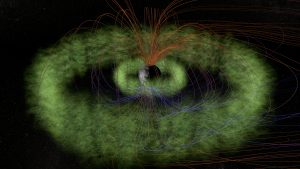15 November 2017
Scientists locate whistling space electrons’ origins
Posted by Nanci Bompey
By Mara Johnson-Groh

The Van Allen Belts, shown in green, are concentric donut-shaped belts filled with charged particles, trapped by Earth’s magnetic field.
Credits: Tony Phillips/NASA
Scientists have long known that solar-energized particles trapped around the planet are sometimes scattered into Earth’s upper atmosphere where they can contribute to beautiful auroral displays. Yet for decades, no one has known exactly what is responsible for hurling these energetic electrons on their way. Recently, two spacecraft found themselves at just the right places at the right time to witness first hand both the impulsive electron loss and its cause.
New research using data from NASA’s Van Allen Probes mission and FIREBIRD II CubeSat has shown that a common plasma wave in space is likely responsible for the impulsive loss of high-energy electrons into Earth’s atmosphere. Known as whistler mode chorus, these waves are created by fluctuating electric and magnetic fields. The waves have characteristic rising tones —reminiscent of the sounds of chirping birds — and are able to efficiently accelerate electrons (listen to the chorus waves here).
The results have been published in a paper in Geophysical Review Letters, a journal of the American Geophysical Union.
“Observing the detailed chain of events between chorus waves and electrons requires a conjunction between two or more satellites,” said Aaron Breneman, researcher at the University of Minnesota in Minneapolis, and lead author on the paper. “There are certain things you can’t learn by having only one satellite — you need simultaneous observations at different locations.”
The study combined data from FIREBIRD II, which cruises at a height of 310 miles above Earth, and from one of the two Van Allen Probes, which travel in a wide orbit high above the planet. From different vantage points, they could gain a better understanding of the chain of cause and effect of the loss of these high-energy electrons.
Far from being an empty void, the space around Earth is a jungle of invisible fields and tiny particles. It’s draped with twisted magnetic field lines and swooping electrons and ions. Dictating the movements of these particles, Earth’s magnetic environment traps electrons and ions in concentric belts encircling the planet. These belts, called the Van Allen Radiation Belts, keep most of the high-energy particles at bay.
Sometimes however, the particles escape, careening down into the atmosphere. Typically, there is a slow drizzle of escaping electrons, but occasionally impulsive bunches of particles, called microbursts, are scattered out of the belts.
Late on January 20, 2016, the Van Allen Probes observed chorus waves from its lofty vantage point and immediately after, FIREBIRD II saw microbursts. The new results confirm that the chorus waves play an important role in controlling the loss of energetic electrons — one extra piece of the puzzle to understand how high-energy electrons are hurled so violently from the radiation belts. This information can additionally help further improve space weather predictions.
— Mara Johnson-Groh is a science writer at the NASA Goodard Space Flight Center. This post originally appeared on the NASA Goddard website.


 GeoSpace is a blog on Earth and space science, managed by AGU’s Public Information staff. The blog features posts by AGU writers and guest contributors on all sorts of relevant science topics, but with a focus on new research and geo and space sciences-related stories that are currently in the news.
GeoSpace is a blog on Earth and space science, managed by AGU’s Public Information staff. The blog features posts by AGU writers and guest contributors on all sorts of relevant science topics, but with a focus on new research and geo and space sciences-related stories that are currently in the news.